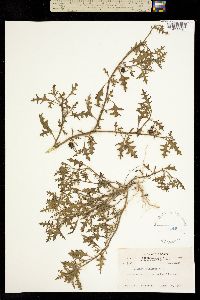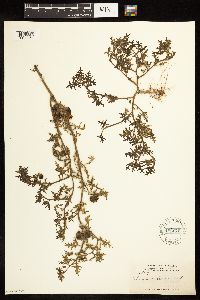Solanum triflorum
|
|
|
|
Family: Solanaceae
Cut-Leaf Nightshade, more...cutleaf nightshade
|
PLANT: Annual herbs, 10-50 cm tall, unarmed, without tubers or stolons, sparsely to densely appressed pubescent; stems divergent, spreading to decumbent. LEAVES: simple, alternate, oblong to ovate, deeply pinnatifid, 2-5 cm long, 1-2 cm wide, ca. 2 times as long as wide, with individual lobes lanceolate, the blade submembranous; petiole 5-20 mm long; apex acute; base cuneate. I INFLORESCENCE: umbels with (1-)2-3(-6)-flowered; peduncle 5-15 mm long. FLOWERS: actinomorphic (Fig. 3E); pedicel up to 5 mm long; calyx 2.5-5 mm long, campanulate, the lobes longer than tube, linear, acute; corolla white, drying yellow, up to 8 mm wide; stamens equal; anthers 2.5-3 mm long, not adherent, straight; filaments about as long as anthers; style about as long as stamens. FRUITS: 9-14 mm in diam., green, ascending, not enclosed by calyx; seeds 2.5-3 mm in diam., many, sub-orbicular, flat, yellow-brown. NOTES: Roadsides, washes, sandy soil, dry scrub lands, juniper woodlands: Apache, Cochise, Coconino, Gila, Maricopa, Mohave, Navajo, Pinal, Yavapai cos. (Fig. 2H); 600-2600 m (2000-8500 ft); May-Sep; c U.S.; native to S. Amer. In times of food shortage the Indians of west central NM boiled the berries, ground them with chili and salt, and ate them as a condiment with mush or bread (Ebeling 1986). REFERENCES: Chiang, F. and L.R. Landrum. Vascular Plants of Arizona: Solanaceae Part Three: Lycium. CANOTIA 5 (1): 17-26, 2009. Wiggins 1964, Kearney and Peebles 1969 Duration: Annual Nativity: Native Lifeform: Forb/Herb General: Annual with prostrate to decumbent branches 10-40 cm long, herbage sparsely scaberulous-pubescent with appressed hairs. Leaves: Ovate to elliptic, pinnatifid or deeply lobed, 1-2 cm wide to 4 cm long, individual lobes or teeth lanceolate, 1.5-3 mmm wide, 3-7 mm long, acute; on petioles 1-1.5 cm long, blade decurrent as a narrow wing about halfway to base. Flowers: On stoutish peduncles 5-15 mm long, 1-6 but usually 3-flowered; pedicels 2-5 mm long at anthesis, 1-12 mm long and distinctly swollen toward apex in fruit; calyx 2.5-3 mm long with lance-ovate lobes equaling or slightly exceeding tube at anthesis, enlarging in fruit and then 3-4 mm wide, 3-5 mm long, clasping the base of berry; corolla white or slightly tinged with green, 6-8 mm in diameter, lobes ovate attenuate, minutely puberulent on outside and on margins near tips; anthers all alike, 2.5-3 mm long, erect or straight. Fruits: Globose berries, 6-10 mm in diameter, greenish at maturity, smooth and sublustrous. Ecology: Found on disturbed sites, roadsides, streamsides, often in sandy soil 1,000-7,000 ft (305-2134 m); flowers May-September. Notes: The deeply pinnatifid leaves help to distinguish this species, as does the 3-flowered tendency. Ethnobotany: A decoction of the berries were taken for diarrhea, stomachaches, used as lotion on horses- sores, the berries were eaten in times of food shortages and famine, planted with watermelons to make them more prolific and ripen earlier. Etymology: Solanum is Latin for quieting, reference to the narcotic properties of some species, while triflorum means three-flowered. Synonyms: None Editor: SBuckley, 2010 Foetid annual, ±prostrate, branched from the base, 1-6 dm, short-hairy or eventually glabrate; lvs short-petiolate, the blade 2-5 נ1-3 cm, evidently pinnatilobate, the rachis seldom wider than the length of the lobes; cal accrescent, the tube short, the rather narrow lobes to 6 mm in fr; fr globose, greenish, 9-14 mm; 2n=24; otherwise like nos. 2 [Solanum nigrum L.] and 3 [Solanum sarrachoides Sendtn.]. Native to w. U.S., occasionally intr. as a weed in our range. Gleason, Henry A. & Cronquist, Arthur J. 1991. Manual of vascular plants of northeastern United States and adjacent Canada. lxxv + 910 pp. ©The New York Botanical Garden. All rights reserved. Used by permission. |































































































